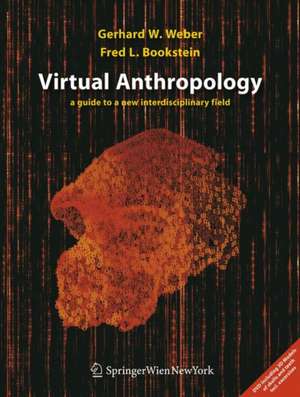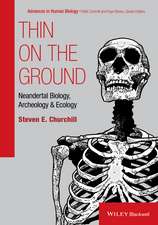Virtual Anthropology: A guide to a new interdisciplinary field
Autor Gerhard W. Weber, Fred L. Booksteinen Limba Engleză Hardback – 22 dec 2010
| Toate formatele și edițiile | Preț | Express |
|---|---|---|
| Paperback (1) | 604.87 lei 6-8 săpt. | |
| SPRINGER VIENNA – 5 mai 2017 | 604.87 lei 6-8 săpt. | |
| Hardback (1) | 640.87 lei 3-5 săpt. | |
| SPRINGER VIENNA – 22 dec 2010 | 640.87 lei 3-5 săpt. |
Preț: 640.87 lei
Preț vechi: 753.96 lei
-15% Nou
Puncte Express: 961
Preț estimativ în valută:
122.63€ • 133.62$ • 103.33£
122.63€ • 133.62$ • 103.33£
Carte disponibilă
Livrare economică 02-16 aprilie
Preluare comenzi: 021 569.72.76
Specificații
ISBN-13: 9783211486474
ISBN-10: 321148647X
Pagini: 250
Ilustrații: XXII, 423 p. With online files/update.
Dimensiuni: 210 x 279 x 35 mm
Greutate: 2 kg
Ediția:2011
Editura: SPRINGER VIENNA
Colecția Springer
Locul publicării:Vienna, Austria
ISBN-10: 321148647X
Pagini: 250
Ilustrații: XXII, 423 p. With online files/update.
Dimensiuni: 210 x 279 x 35 mm
Greutate: 2 kg
Ediția:2011
Editura: SPRINGER VIENNA
Colecția Springer
Locul publicării:Vienna, Austria
Public țintă
ResearchCuprins
Chapter 1: Virtual Anthropology: A new interdisciplinary field of science
Chapter 2: Mapping the physical world: Digitise
Chapter 3: Looking inside: Expose
Chapter 4: Using numbers: Compare
Chapter 5: Missing data: Reconstruct
Chapter 6: Back to the real world: Materialise
Chapter 7: Collaborate at the speed of light: Share
Chapter 8: Views into the future
Chapter 2: Mapping the physical world: Digitise
Chapter 3: Looking inside: Expose
Chapter 4: Using numbers: Compare
Chapter 5: Missing data: Reconstruct
Chapter 6: Back to the real world: Materialise
Chapter 7: Collaborate at the speed of light: Share
Chapter 8: Views into the future
Notă biografică
Gerhard W. Weber is associate professor in the Department of Anthropology at the University of Vienna. A pioneer in digital extensions of anthropology since the early 1990s, he leads the Virtual Anthropology workgroup and the Vienna Micro-CT Lab as well as other projects at the University of Vienna towards centred on the new technology. He also established the digital@rchive of Fossil Hominoids and initiated and coordinated the EU-funded European Virtual Anthropology Network. He has been active for a decade in field work in the Afar Triangle in Ethiopia. His teaching comprises applied statistics, human evolution, and Virtual Anthropology. Fred L. Bookstein, an American, is Professor of Morphometrics at the University of Vienna and Professor of Statistics at the University of Washington, Seattle. He is the principal figure responsible for the emergence of Morphometrics over the last quarter-century as an interdisciplinary method combining medical imaging, analytic geometry, and multivariate statistics in novel tools for the analysis of biological form and its variation. The course he most enjoys teaching is Numbers and Reasons, about the origins of quantitative methods in the real world.
Textul de pe ultima copertă
This is the first textbook of Virtual Anthropology, the new science that combines elements from fields as diverse as anthropology, medicine, statistics, computing, scientific visualization, and industrial design. The book is intended for students in any of these or nearby fields within biology, medicine, or engineering and for teachers, journalists, and all others who will enjoy the many examples from our real biological world. After a general introduction to the field and an overview, the book is organized around six themes conveyed in more than 300 pages of text accompanied by hundreds of carefully annotated images: medical imaging and 3D digitising techniques, electronic preparation of individual specimens, analysis of complex forms in space one or many at a time, reconstruction of forms that are partly missing or damaged, production of real objects from virtual models, and, finally, thoughts about data accessibility and sharing and the implications of all this for the future of anthropology. The authors' emphasis is not on technical details but rather on step-by-step explanations of the wealth of examples included here, from brain evolution to surgical planning, always in light of the relevance of these approaches to science and to society. All readers are encouraged to try out the techniques on their own using the tools and data included in the Online Extra Materials resource.
Caracteristici
New and unique textbook to a new branch of science Interdisciplinary approach Online material with instructive exercises
















